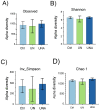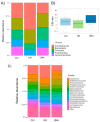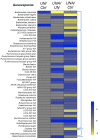Dietary Supplementation with Popped Amaranth Modulates the Gut Microbiota in Low Height-for-Age Children: A Nonrandomized Pilot Trial
- PMID: 37509852
- PMCID: PMC10379428
- DOI: 10.3390/foods12142760
Dietary Supplementation with Popped Amaranth Modulates the Gut Microbiota in Low Height-for-Age Children: A Nonrandomized Pilot Trial
Abstract
Amaranth has been recognized as a nutraceutical food because it contains high-quality proteins due to its adequate amino acid composition that covers the recommended requirements for children and adults. Since pre-Hispanic times, amaranth has been consumed as popped grain; the popping process improves its nutritive quality and improves its digestibility. Popped amaranth consumption has been associated with the recovery of malnourished children. However, there is no information on the impact that popped amaranth consumption has on gut microbiota composition. A non-randomized pilot trial was conducted to evaluate the changes in composition, structure, and function of the gut microbiota of stunted children who received four grams of popped amaranth daily for three months. Stool and serum were collected at the beginning and at the end of the trial. Short-chain fatty acids (SCFA) were quantified, and gut bacterial composition was analyzed by 16S rRNA gene sequencing. Biometry and hematology results showed that children had no pathology other than low height-for-age. A decrease in the relative abundance of Alistipes putredinis, Bacteroides coprocola, and Bacteroides stercoris bacteria related to inflammation and colitis, and an increase in the relative abundance of Akkermansia muciniphila and Streptococcus thermophiles bacteria associated with health and longevity, was observed. The results demonstrate that popped amaranth is a nutritious food that helps to combat childhood malnutrition through gut microbiota modulation.
Keywords: 16S rRNA sequencing; diet; gut microbiota; popped amaranth; short-chain fatty acids.
Conflict of interest statement
The authors declare no conflict of interest.
Figures








Similar articles
-
Protein quality evaluation of amaranth in adult humans.Plant Foods Hum Nutr. 1993 Mar;43(2):123-43. doi: 10.1007/BF01087917. Plant Foods Hum Nutr. 1993. PMID: 8475000
-
Dry heat popping of amaranth seed might damage some of its essential amino acids.Plant Foods Hum Nutr. 1989 Dec;39(4):299-309. doi: 10.1007/BF01092066. Plant Foods Hum Nutr. 1989. PMID: 2631086
-
Virtualized clinical studies to assess the natural history and impact of gut microbiome modulation in non-hospitalized patients with mild to moderate COVID-19 a randomized, open-label, prospective study with a parallel group study evaluating the physiologic effects of KB109 on gut microbiota structure and function: a structured summary of a study protocol for a randomized controlled study.Trials. 2021 Apr 2;22(1):245. doi: 10.1186/s13063-021-05157-0. Trials. 2021. PMID: 33810796 Free PMC article.
-
[Amaranth, quinoa and buckwheat grain products: role in human nutrition and maintenance of the intestinal microbiome].Vopr Pitan. 2022;91(6):17-29. doi: 10.33029/0042-8833-2022-91-6-17-29. Epub 2022 Oct 10. Vopr Pitan. 2022. PMID: 36648179 Review. Russian.
-
The effects of inulin on gut microbial composition: a systematic review of evidence from human studies.Eur J Clin Microbiol Infect Dis. 2020 Mar;39(3):403-413. doi: 10.1007/s10096-019-03721-w. Epub 2019 Nov 9. Eur J Clin Microbiol Infect Dis. 2020. PMID: 31707507
Cited by
-
Amaranthus crop for food security and sustainable food systems.Planta. 2024 Jul 24;260(3):59. doi: 10.1007/s00425-024-04490-3. Planta. 2024. PMID: 39046582 Review.
-
Amaranth and buckwheat grains: Nutritional profile, development of functional foods, their pre-clinical cum clinical aspects and enrichment in feed.Curr Res Food Sci. 2024 Sep 2;9:100836. doi: 10.1016/j.crfs.2024.100836. eCollection 2024. Curr Res Food Sci. 2024. PMID: 39290651 Free PMC article. Review.
-
Prospects for the Use of Amaranth Grain in the Production of Functional and Specialized Food Products.Foods. 2025 May 1;14(9):1603. doi: 10.3390/foods14091603. Foods. 2025. PMID: 40361686 Free PMC article. Review.
-
Impact of dance classes on motor and cognitive functions and gut microbiota composition in multiple sclerosis patients: Randomized controlled trial.Eur J Sport Sci. 2024 Aug;24(8):1186-1196. doi: 10.1002/ejsc.12166. Epub 2024 Jul 5. Eur J Sport Sci. 2024. PMID: 38967986 Free PMC article. Clinical Trial.
References
-
- WHO/UNICEF Levels and Trends in Child Malnutrition: UNICEF/WHO/The World Bank Group Joint Child Malnutrition Estimates: Key Findings of the 2021 Edition. Retrieved October 2022. [(accessed on 4 March 2023)]. Available online: https://www.who.int/publications/i/item/9789240025257.
Grants and funding
LinkOut - more resources
Full Text Sources

